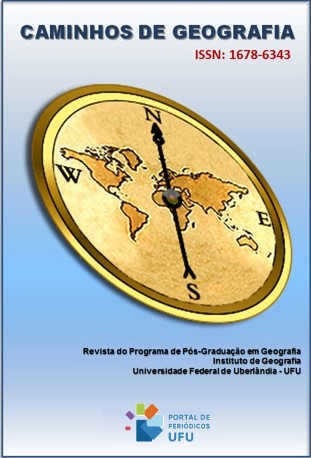DISTRIBUIÇÃO ESPAÇO-TEMPORAL DOS TRANSTORNOS MENTAIS E COMPORTAMENTAIS RELACIONADOS AO USO DE SUBSTÂNCIAS PSICOATIVAS NO ESTADO DE SÃO PAULO, BRASIL
DOI:
https://doi.org/10.14393/RCG259970593Palavras-chave:
Estatística espacial em saúde, Geoprocessamento, Mapeamento temáticoResumo
Transtornos Mentais e Comportamentais (TMC) são caracterizados por perturbações na cognição, regulação emocional e comportamento do indivíduo. Este estudo realizou o mapeamento multitemporal da taxa de TMC no Estado de São Paulo entre 2008 e 2021. A detecção e análise de agrupamento espacial foi realizada com técnicas de estatística espacial. Existe uma dependência espacial entre os municípios do estado de São Paulo quanto à taxa de TMC no período de 2008 a 2021. Uma oscilação nos casos de TMC nos municípios nos últimos anos foi evidenciada. Os homens são mais acometidos que as mulheres e a faixa etária de 20 a 59 anos de idade a de maior risco. Conclui-se que o padrão de distribuição da taxa de TMC não é aleatório no Estado de São Paulo, sendo as mesorregiões de Campinas, Assis e Marília as mais preocupantes no estado. Este trabalho encontrou padrões e tendências na distribuição da taxa de TMC relacionados ao uso de substâncias psicoativas em diferentes regiões do Estado de São Paulo. Isso pode ajudar a planejar e implementar políticas públicas mais efetivas de prevenção e tratamento para esses transtornos nas áreas de maior ocorrência.
Downloads
Downloads
Publicado
Edição
Seção
Licença
Copyright (c) 2024 Felipe de Oliveira Barbosa, Mariany Kerriany Gonçalves de Souza, Ana Paula Alves Favareto, Renata Calciolari Rossi, Edmur Azevedo Pugliesi, Renan Furlan de Oliveira, Ana Paula Marques Ramos

Este trabalho está licenciado sob uma licença Creative Commons Attribution-NonCommercial-NoDerivatives 4.0 International License.
Autores que publicam nesta revista concordam com os seguintes termos: a) Autores mantém os direitos autorais e concedem à revista o direito de primeira publicação, com o trabalho licenciado sob a Creative Commons Atribuição-NãoComercial-SemDerivações 4.0 Internacional. b) Autores têm permissão e são estimulados a publicar e distribuir seu trabalho online (ex.: em repositórios institucionais ou na sua página pessoal), já que isso pode gerar alterações produtivas, bem como aumentar o impacto e a citação do trabalho publicado. c) Em virtude de aparecerem nesta revista de acesso público, os artigos são de uso gratuito, com atribuições próprias, em aplicações educacionais e não-comerciais.











